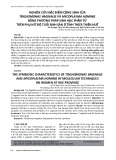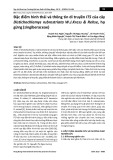
Tập 18 Số 4-2024, Tạp chí Khoa học Tây Nguyên
24
MOLECULAR ANALYSIS AND CLONING OF A CELLULASE GENE FROM
Bacillus velezensis RB.IBE29
Tran Minh Dinh1, Pham Thi Thu Thuy2, Nguyen Thi Huyen1
Received Date: 25/6/2024; Revised Date: 02/8/2024; Accepted for Publication: 03/8/2024
ABSTRACT
Bacillus velezensis RB.IBE29 was originally isolated from the rhizospheric soil of black pepper
cultivated in the Central Highlands. Previous studies showed that this bacterium was a good chitinase
producer, biocontrol agent, and biofertilizer. The complete genome sequence of strain RB.IBE29 was
reported and revealed that it harbors the gene coding for the family 5 cellulase of glycoside hydrolases,
however, this gene has not been experimentally characterized. This small work aimed to analyze and
clone the gene encoding the family 5 cellulase of strain RB.IBE29 for subsequent studies. Results
showed that strain RB.IBE29 possesses the celA encoding the family 5 cellulase. The ORF of the celA
contains 1500 bp and encodes cellulase with 499 aa and 55.0 kDa. Primary structure analysis found
that the enzyme contains a signal peptide sequence at the N-terminus, a GH5 catalytic domain, and a
CBM3 domain at C-terminus. A fragment (1410 bp) without signal peptide sequence was successfully
amplified and cloned in Escherichia coli DH5α. Sequencing analysis confirmed that no mutations
or frameshift mutations were found in the insert of the recombinant vector from the positive clone.
This work provided valuable material for our next expression, purification, and characterization of the
cellulase from strain RB.IBE29.
Keywords: Cellulase; the glycoside hydrolase family 5; gene cloning; Bacillus velezensis RB.IBE29
1. INTRODUCTION
Cellulose is the most abundant biopolymer on
Earth and the primary structural component of plant
and algal cell walls. Cellulases are enzymes that
hydrolyze β-1,4-glycosidic linkage in cellulose.
Various microorganisms produce cellulases,
such as fungi and bacteria. In agriculture, it was
reported that cellulase-producing microorganisms
can treat agricultural wastes and convert them to
biofertilizers for crop production (Juturu et al.,
2014).
Bacillus velezensis is a strong biocontrol and
plant-growth promoting agent, and has been
applied for agricultural cultivation (Cai et al. 2024;
Fan et al., 2018). B. velezensis RB.IBE29 was
isolated from the rhizospheric soil of black pepper
cultivated in the Central Highlands. Cells of strain
RB.IBE29 exhibited high activities of chitinase,
β-glucanase, and protease; produced indole-3-
acetic acid; solubilized insoluble phosphate; and
suppressed the growth of Phytophthora, a fungal
pathogen of black pepper (Trinh et al., 2019).
According to field experiments, strain RB.IBE29
was a good biological agent for producing
black pepper sustainably (Nguyen et al., 2021).
Strain RB.IBE29 possessed two novel family 18
chitinases. These enzymes have been expressed in
E. coli cells, and purified recombinant chitinases
strongly inhibited the germination of fungal spores
and the hatching of nematode eggs (Tran et al.,
2022a,b). A xylanase gene of strain RB.IBE29 has
been expressed, and purified recombinant xylanase
was active at a wide range of temperatures and
pHs (Tran et al., 2024). The complete genome
of strain RB.IBE29 was sequenced and provide
valuable genomic information for biotechnological
application (Tran et al., 2023). Among them, one
gene encoding cellulase belonging to family 5
was found in the genome of strain RB.IBE29;
however, this enzyme has not been experimentally
characterized. Hence, this small work reported
the molecular analysis and cloning of the gene
encoding the family 5 cellulase from B. velezensis
RB.IBE29 in E. coli DH5α. The cloned gene was
valuable for further expressing, purifying, and
characterizing this enzyme.
2. MATERIALS AND METHODS
2.1. Materials
The genome sequence of B. velezensis
RB.IBE29 (DDBJ/EMBL/Genbank accession
AP028932) was used to search for and analyze the
cellulase gene. B. velezensis RB.IBE29 (Trinh et
al., 2019) was used to isolate the cellulase gene. E.
coli DH5α (New England Biolabs, USA) was the
competent cell. pUC19 (Thermo Fisher Scientific,
USA) was used as the cloning vector. Luria-Bertani
(LB) medium was used for bacterial growth.
1Institute of Biotechnology and Environment, Tay Nguyen University;
2University of Science, Viet Nam National University - Ho Chi Minh City;
Corresponding author: Tran Minh Dinh; Tel: 0943095079; Email: tmdinh@ttn.edu.vn

Tập 18 Số 4-2024, Tạp chí Khoa học Tây Nguyên
25
2.2. Methods
2.2.1. Searching and analyzing the cellulase gene
The open reading frame (ORF) was examined
using ORF finder (www.ncbi.nlm.nih.gov/
orffinder/). The signal peptide sequence was
identified using SignalP 5.0 (Almagro Armenteros
et al., 2019). The primary structure was analyzed
using the SMART 9.0 (Letunic et al., 2020).
Molecular weight was calculated using the
Compute pI/Mw tool (Gasteiger et al., 2005).
The BLASTp program (Johnson et al., 2008) was
used to examine the homology of nucleotide and
amino acid sequences. Phylogenetic analysis was
conducted using MEGA 6.0 (Tamura et al., 2013).
2.2.2. Extraction of the genomic DNA
The genomic DNA of B. velezensis RB.IBE29
(Trinh et al., 2019) was obtained from an overnight
culture (16 h) by boiling for 5 min followed
by centrifuge (13,000 rpm, 1 min, 4°C). The
supernatant was used as a template for polymerase
chain reaction (PCR) (Tran et al., 2018; Pentekhina
et al. 2020).
2.2.3. Gene cloning and sequencing analysis
A fragment without signal peptide sequence
(1410 bp) of the celA was amplified from the
genomic DNA of B. velezensis RB.IBE29 by PCR.
A 50-µL reaction mixture contained Cel-F 5’-GG
TGGTGGATCCGCAGGGACAAAAACCCCA
GTAG-3’(underlines indicate cleavage sites for
BamHI and HindIII, respectively), and Phusion
High-Fidelity DNA polymerase (Thermo Fisher
Scientific, USA), per the supplier’s instructions.
Primers were designed based on the gene ending
the family 5 cellulase (accession RBIBE_18160)
of B. velezensis RB.IBE29 using the online
OligoAnalyzer tool (www.idtdna.com/pages/tools/
oligoanalyzer). The reaction mixture was incubated
under a schedule consisting of predenaturation at
98°C for 3 min; followed by 40 cycles of 98°C for 10
sec, 55°C for 20 sec, and 72°C for 45 sec; and 72°C
for 5 min. Electrophoresis was used to separate the
amplified products on a 1.2% agarose gel. The target
band was then cut out and purified using the Wizard
SV Gel and PCR Clean-Up System (Promega,
USA), following the manufacturer’s protocol.
The vector pUC19 and insert were incubated
individually with the FastDigest BamHI and
HindIII (Thermo Fisher Scientific, USA),
following the manufacturer’s instructions. The
product was then analyzed using electrophoresis
on 1.5% agarose gel. The treated vector and insert
were ligated using the Mighty Mix (Takara, Japan)
to generate the recombinant vector utilizing the
manufacturer’s instruction. The recombinant vector
was introduced into E. coli DH5α by heat shock.
Transformants were spread on LB agar plates
containing X-gal (0.04 mg/mL), ampicillin (100
μg/mL), and Isopropyl β-D-thiogalactopyranoside
(0.1 mM) (IPTG) and incubated at 37°C for 24 h.
The recombinant vector from white colonies
was examined by colony-PCR. A 10-µL reaction
mixture contained bacterial cells of the white
colony, primers Cel-F and Cel-R, and Taq DNA
polymerase (Bioline, USA), per the supplier’s
instructions. The reaction mixture was incubated
under a schedule consisting of predenaturation at
95°C for 3 min; followed by 40 cycles of 95°C
for 10 sec, 55°C for 15 sec, and 72°C for 15 sec;
and 72°C for 5 min. Electrophoresis was used
to separate the amplified products on a 1.0%
agarose gel. After that, recombinant vectors from
positive colonies were isolated and purified using
the GeneJET Plasmid Miniprep Kit (Thermo
Fisher Scientific, USA), per the supplier’s
instruction. The insert from purified recombinant
vectors was sequenced at the 1st BASE Company
(Selangor, Malaysia) using primers M13-F
5’-CCCAGTCACGACGTTGTAAAACG-3’
and M13-R
5’-AGCGGATAACAATTTCACACAGG-3’.
3. RESULTS AND DISCUSSIONS
3.1. Sequence analysis of deduced cellulase gene
Analysis based on the complete genome
sequence of strain RB.IBE29 showed that the
genome of strain RB.IBE29 possesses the gene
(celA) coding for the family 5 cellulase.
Fig. 1A shows that the ORF of the celA contains
1500 bp and encodes the cellulase with 499 aa.
The molecular weight of the deduced cellulase
was calculated to be 55.0 kDa. Sequence analysis
exhibited that amino acids of the B. velezensis
RB.IBE29 cellulase shared the maximum identity
(99.6%) to those of a cellulase (WP_302242883.1)
of B. velezensis, followed by 99.19% to cellulase
(WP_256890651.1) of B. amyloliquefaciens,
98.79% to a cellulase (ABS70712.1) of B.
subtilis, 97.98% to a cellulase (WP_133489245.1)
of B. inaquosorum, and 97.98% to a cellulase
(WP_047474757.1) of B. siamensis. The primary
structure of the enzyme contains a signal peptide
at the N-terminus, a GH5 catalytic domain, and a
CBM3 domain at the C-terminus (Fig. 1B).

Tập 18 Số 4-2024, Tạp chí Khoa học Tây Nguyên
26
Fig. 1. Nucleotide of cellulase gene and its amino acid sequence, and primary structure of cellu-
lase from strain RB.IBE29.
Note: A, the nucleotide sequence of cellulase gene and its amino acid sequence; B, the primary
structure of deduced cellulase; SP: signal peptide sequence; GH5, GH5 catalytic domain; CBM3,
carbohydrate-binding module family 3.
To visualize the relationship between cellulase
of strain RB.IBE29 and reported bacterial
enzymes, a phylogenetic tree was analyzed using
MEGA 6.0. The result showed that cellulase of
strain RB.IBE29 was grouped with bacterial
cellulases (Fig. 2). These analyses confirmed the
enzyme is cellulase.
Fig. 2. Phylogenetic analysis of the cellulase from strain RB.IBE29 and reported enzymes

Tập 18 Số 4-2024, Tạp chí Khoa học Tây Nguyên
27
3.2. Cloning of the cellulase gene
Fig. 3A shows that several white colonies grew
on the LB agar plate containing X-gal, ampicillin,
and IPTG. Using primers M13-F and M13-R, the
insert was identified from the white colonies using
colony-PCR (Fig. 3B). These results indicated
the celA (without signal peptide sequence) of B.
velezensis RB.IBE29 was successfully cloned in
E. coli DH5α.
Fig. 3. Transformed cells grown on the LB agar plate containing X-gal, ampicillin, and IPTG,
and examination of positive clones by colony-PCR.
Note: A, the transformed cells grown on the LB agar plate containing X-gal, ampicillin, and IPTG; B,
the examination of positive clones by colony-PCR. The arrow indicates the target PCR product; Lane M
indicates in marker in kilobase; Lanes 1-9 indicate samples.
3.3. Examination of the insert from the clone
harboring the recombinant vector
To examine any mutations caused by
amplification of the insert, the insert from purified
recombinant vectors was sequenced using primers
M13-F and M13-R. The result showed that no
mutations or frameshift mutations were found
in the insert of the recombinant vector from the
positive clone (Fig. 4). This result suggested that
the recombinant vector is valuable for subsequent
studies concerning the expression and purification
of the cellulase.
Fig. 4. Comparison of nucleotides of the insert from the positive clone and those of the intact celA

Tập 18 Số 4-2024, Tạp chí Khoa học Tây Nguyên
28
1Viện Công nghệ Sinh học và Môi trường, Trường Đại học Tây Nguyên;
2Trường Đại học Khoa học Tự nhiên, Đại học Quốc gia TP. Hồ Ch Minh;
Tác giả liên hệ: Trần Minh Định; ĐT: 0943095079; Email: tmdinh@ttn.edu.vn.
4. CONCLUSIONS
B. velezensis RB.IBE29 possesses a gene
(celA) encoding cellulase belonging to family 5.
The ORF of the celA contains 1500 bp in length
and encodes cellulase with 499 aa and 55.0 kDa.
The primary structure of the enzyme contains the
signal peptide at the N-terminus, the GH5 catalytic
domain, and the CBM3 domain at the C-terminus.
A fragment without signal peptide (1410 bp) was
successfully cloned in E. coli DH5α. No mutations
or frameshift mutations were found in the insert
of the recombinant vector from the positive clone.
This work provided valuable material for the next
expression, purification, and characterization of
the cellulase from strain RB.IBE29.
Acknowledgments
This work was supported by the Ministry
of Education and Training under grant number
B2023-TTN-05.
PHÂN TÍCH PHÂN TỬ VÀ TẠO DÒNG GENE MÃ HÓA CELLULASE CỦA
Bacillus velezensis RB.IBE29
Trần Minh Định1, Phạm Thị Thu Thủy2, Nguyễn Thị Huyền1
Ngày nhận bài: 25/6/2024; Ngày phản biện thông qua: 02/8/2024; Ngày duyệt đăng: 03/8/2024
TÓM TẮT
Bacillus velezensis RB.IBE29 được phân lập từ đất vùng rễ cây hồ tiêu trồng tại Tây Nguyên. Các
nghiên cứu trước đây cho thấy, đây là tác nhân sản xuất chitinase, kiểm soát sinh học và phân bón sinh
học. Trình tự bộ gen của chủng RB.IBE29 đã được công bố và sở hữu gen mã hóa cellulase họ 5, tuy
nhiên, gen này chưa được nghiên cứu bằng thực nghiệm. Mục tiêu của nghiên cứu nhằm phân tích phân
tử và tạo dòng gen mã hóa cellulase họ 5 của chủng RB.IBE29 để tạo vật liệu cho các nghiên cứu tiếp
theo. Kết quả nghiên cứu cho thấy, chủng RB.IBE29 sở hữu celA mã hóa cellulase họ 5. ORF của celA
gồm 1500 bp và mã hóa cellulase với 499 aa và 55,0 kDa. Cấu trc bậc một của cellulase gồm chuỗi
peptide tín hiệu ở đầu N, domain xc tác họ 5 và domain CBM3 ở đầu C của chuỗi polypeptide. Trình
tự (1410 bp) nhưng không bao gồm đoạn peptide tín hiệu được khuếch đại và tạo dòng thành công trong
Escherichia coli DH5α. Phân tích giải trình tự cho thấy không có đột biến cũng như đột biến dịch khung
xảy ra ở trình tự gen mục tiêu trong vectơ tái tổ hợp của khuẩn lạc dương. Nghiên cứu này cung cấp
nguồn vật liệu có giá trị cho nghiên cứu tiếp theo về biểu hiện, tinh sạch và xác định đặc tính sinh học
của cellulase.
Từ khóa: Cellulase; enzyme thủy phân đường họ 5; tạo dòng gene; Bacillus velezensis RB.IBE29.
REFERENCES
Almagro Armenteros, J.J. et al. (2019). SignalP 5.0 improves signal peptide predictions using deep
neural networks. Nature Biotechnology, 37(4), 420–423.
Cai, Z., et al. (2024). Introduction of Cellulolytic Bacterium Bacillus velezensis Z2.6 and Its Cellulase
Production Optimization. Microorganisms, 12, 979.
Fan, B. et al. (2018). Bacillus velezensis FZB42 in 2018: the gram-positive model strain for plant growth
promotion and biocontrol. Front Microbiol, 9, 2491.













![Bài tập Đa dạng thế giới sống [kèm đáp án/ hướng dẫn giải]](https://cdn.tailieu.vn/images/document/thumbnail/2025/20251123/thaohoang9203@gmail.com/135x160/5861763951302.jpg)











![Câu hỏi trắc nghiệm Tế bào nhân sơ [mới nhất]](https://cdn.tailieu.vn/images/document/thumbnail/2025/20251104/xuangiao2601/135x160/40491762309854.jpg)
